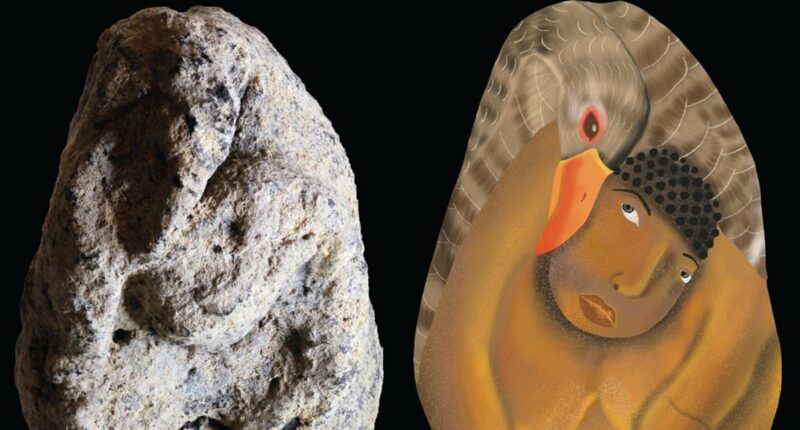Share this @internewscast.com
Archaeologists in Israel have unearthed an unusual ancient figurine portraying a provocative scene—a goose appearing to engage with a woman intimately.
This intriguing clay artifact, measuring a mere 1.4 inches (3.7 cm) in height, was discovered at a prehistoric site in northern Israel.
Experts suggest this may be the earliest known figurine to depict an interaction between humans and animals.
Laurent Davin, the archaeologist from the Hebrew University of Jerusalem responsible for the discovery, described it as ‘extraordinary in several aspects’.
In a conversation with the Daily Mail, he explained, “The scene illustrates the imagined union of a gander spirit and a woman.”
He added, “Such conceptual unions between animal spirits and humans are prevalent in animistic cultures worldwide, often occurring in contexts like erotic dreams, shamanic visions, and myths.”
Although the detail is hard to make out, scientists have recreated the scene in a new illustration.
It shows the naked woman being mounted from behind by the large goose, which tenderly positions its beak against the woman’s head.

A 12,000-year-old clay figurine unearthed in northern Israel, depicting a woman and a goose, is the earliest known human-animal interaction figurine
The ‘extremely rare’ figurine was one of several clay fragments that Davin found at Nahal Ein Gev II, a prehistoric archaeological site in northern Israel.
Two symmetrical oval shapes below the face are breasts, he claims, while a triangular area on the lower part of the figurine is said to be the female pubis.
Aside from bestiality, one alternative interpretation is that the naked woman is a hunter who is transporting the slain goose on her back.
But the goose – a bird common in the Natufian diet – appears to be alive rather than hunted and the more dominant figure in the scene.
Analysis suggests it was modeled from local clay and then heated at about 400°C (752°F) approximately 12,000 years ago.
At the time, Israel was inhabited by the Natufians, a hunter-gatherer culture that flourished in modern-day Israel, Jordan, Lebanon and Syria.
The Natufian culture, spanning roughly 15,000 to 11,500 years ago, marked humanity’s transition from nomadic foragers to settled communities.
Natufians were the first eastern Mediterranean culture to build permanent homes, establish villages and tend to crops, as opposed to hunter-gatherers who would live in different areas based on seasonal availability.

Dr Laurent Davin (left) and Professor Leore Grosman (right) with the small figurine, only 1.4-inch (3.7cm) tall

The Natufian culture, spanning roughly 15,000 to 11,500 years ago, marked humanity’s transition from nomadic foragers to settled communities
They were also skilled brewers, with the ‘world’s oldest brewery’ in the region dating back 13,000 years.
‘The NEG II figurine captures a transformative moment,’ said Leore Grosman, professor of prehistoric archaeology at the Hebrew University.
‘It bridges the world of mobile hunter gatherers and that of the first settled communities, showing how imagination and symbolic thinking began to shape human culture.’
Natufians are thought to have had close spiritual relationships with animals, although it’s not known if this commonly extended to intimate encounters.
The researchers interpret the figure as an imagined or mythological encounter consistent with the ancient ‘animistic’ belief system – in which humans and animals are spiritually interconnected.
The focus on a goose and a woman, the researchers argue, points to an early mythic imagination that later blossomed in Neolithic cults across Southwest Asia.
Remains from Nahal Ein Gev II already suggest geese were a revered part of ritual life for the Natufians, while the birds’ feathers were used for decoration, while certain bones were fashioned into ornaments.
‘This object is both the earliest naturalistic representation of a woman in Southwest Asia and the earliest figurine to depict a human–animal interaction,’ the team say.

Two symmetrical oval shapes below the face are breasts, while a triangular area on the lower part of the figurine likely the female pubis
‘Notably, the depicted interaction is not related to hunting but presents a mythological scene between a human and a bird.’
Paleolithic representations of human–animal interaction are rare, with only a few painted or engraved examples recorded, mostly from Europe.
Such scenes, depicting real or imagined interactions, are of major importance for understanding a wide range of past human perspectives,’ the scientists say.
‘Shifts in perspective led human communities to manipulate and transform their environment while simultaneously depicting new forms of art featuring human–animal interactions.’
The figurine is described further in a new paper published in the journal Proceedings of the National Academy of Sciences.







